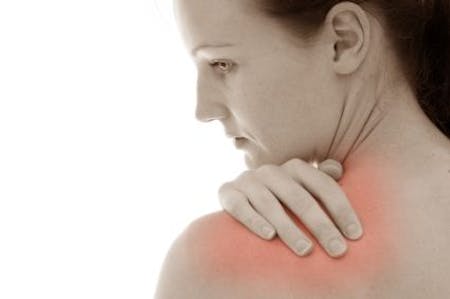
The shoulder is a large and complex synovial, ball and socket joint located between the head of the humerus (upper arm one) and the glenoid cavity (articular surface) of the scapula. It is extremely flexible and mobile. But, with that mobility comes vulnerability. The three ball-and-socket joints within the shoulder are vulnerable to the same conditions as other synovial joints in the body. The most common conditions are instability due to injury, osteoarthritis, infection and rheumatoid disease.
Common Shoulder Disorders
The floating ST joint is vulnerable to such painful conditions as:
- Scapular Winging - lateral scapular winging, medial scapular winging and pseudo-winging are caused by the trapezius (serratus anterior) failing to stabilize the scapula.
- Snapping Scapula Syndrome - a grating sensation often caused by overuse and scapulothoracic bursitis.
- Scapulothoracic Dyskinesis - abnormal scapula motion that disrupts the normal glenohumeral joint mechanics and leads to shoulder pain.
- Scapulothoracic Dissociation - a disruption of the ST joint associated with high-energy trauma.
The Glenohumeral Joint
The glenohumeral joint is the main shoulder joint. It is the most mobile of any joint in the body and the most unstable. It is the most commonly dislocated joint in the shoulder. Watch the video below to learn more.
Other common shoulder disorders include:
- Fracture - Fractures (broken bones) commonly occur in the clavicle (collar bone), proximal humerus (top of the upper arm bone) and scapula (shoulder blade).
- Dislocation - when the bones on opposite sides of a joint do not line up. Dislocations occur in any of the three ball-and-socket shoulder joints: glenohumeral, acromioclavicular or sternoclavicular.
- Acromioclavicular (AC) Separation - an AC separation is also known as a separated shoulder. It is often caused by a fall or hard blow that tears ligaments that surround and protect the joint where your collarbone and shoulder blade come together.
- SLAP Tear - a Superior Labrum, Anterior to Posterior (SLAP) tear is also known as a labrum tear or cartilage tear. It is a tear in the lining of the shoulder socket rim that deepens the shoulder joint socket, which creates a stronger fit for the head of the humerus. It can be caused by overuse or a traumatic injury.
- Rotator Cuff Tear - an injury to the group of muscles and tendons in your shoulder that hold your arm in place and let you lift your arm overhead caused by overuse, a traumatic injury or wear and tear as you age.
- Frozen Shoulder - abnormal bands of tissue (adhesions) build up in the joint causing the shoulder to stiffen ("freeze") due to pain or surgery.
- Impingement - the rotator cuff gets pinched in the shoulder bones, which can cause pain and swelling.
- Bursitis - inflammation or irritation to the fluid-filled sac (bursa) in your shoulder that causes pain and swelling, especially when you move your shoulder.
- Tendinitis - tiny tears in one or more tendons in your shoulder that can cause pain and swelling and makes it difficult to move. Tendinitis is usually caused by repetitive or overuse of the shoulder or by a sudden traumatic injury, such as a sports injury, sudden fall or automobile accident.
- Tendinopathy/Tendinosis - although the symptoms are similar to tendinitis, tendinopathy/tendonosis is a different condition. It is the degeneration of the collagen protein that forms the tendon caused by a combination of repetitive use, poor blood supply to the distal (outer) end of the tendon and age-related degenerative change.
Physical Therapy for Shoulder Pain
The good news is that many shoulder injuries and conditions can be treated conservatively. Our physical therapists (PTs) are experts in the art and science of the evaluation and treatment of shoulder dysfunctions (abnormalities). We care for people of all ages and successfully treat a variety of muscle, ligament, tendon, joint and neurological conditions.
Components of your care typically include:
- A thorough biomechanical evaluation.
- Customized treatment plan.
- Extensive patient education.
- Hands-on techniques to relax the muscles and recover mobility.
- Stretching for tight muscles.
- Strengthening of weak muscles.
- Mobilization of stiff joints.
- Modalities such as ice, heat, ultrasound or electrical stimulation.
Advantages of Physical Therapy:
- No side effects.
- Cost-effective.
- Supported by clinical research*.
- Customized to treat the underlying cause.
Visit our Medical Library for more information on shoulder pain.
